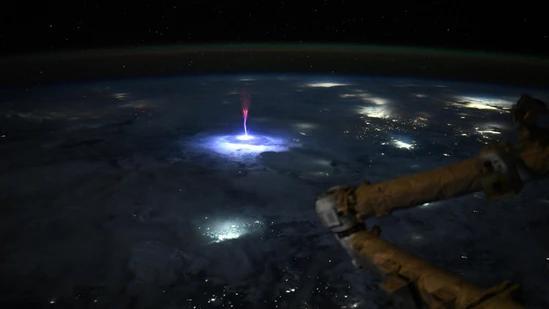
NASA Astronaut Captures Rare ‘Sprite’ Lightning Over US & Mexico
In a breathtaking display of celestial wonder, NASA astronaut Nichole Ayers has captured a rare and awe-inspiring phenomenon known as ‘sprite’ lightning while orbiting above the United States and Mexico from the International Space Station (ISS). The extraordinary image showcases a brief burst of light, known as a Transient Luminous Event (TLE), which occurs above thunderstorms.
Ayers, a seasoned astronaut with numerous space missions under her belt, shared the remarkable photo on social media, sending the scientific community into a frenzy of excitement. The image is a testament to the incredible capabilities of the ISS, which provides a unique platform for astronauts to capture and study rare atmospheric phenomena.
What are Sprites?
Sprites are a type of TLE, characterized by brief bursts of light that occur above thunderstorms. These atmospheric events are caused by the discharge of electrical energy between the cloud and the ionosphere, a region of the atmosphere that extends from about 50 to 600 kilometers above the Earth’s surface.
During a thunderstorm, the electrical discharge from the cloud can create a channel of ionized air, known as a “leader,” which connects the cloud to the ionosphere. When this leader reaches the ionosphere, it can create a spark of light, known as a sprite, which can be thousands of kilometers long.
Capturing Sprites from Space
Astronauts on the ISS have the unique advantage of being able to capture sprites from space, providing scientists with a rare and valuable glimpse into the inner workings of thunderstorms. The ISS orbits the Earth at an altitude of approximately 250 miles (400 kilometers), allowing astronauts to observe the atmosphere from a perspective that is not possible from the ground.
Ayers’ photo is a stunning example of the incredible views that can be captured from the ISS. The image shows a vibrant blue and purple sprite stretching across the sky, illuminated by the faint glow of the Earth’s atmosphere. The sprite appears to be connected to a thunderstorm cloud, which is visible in the distance.
Scientific Significance
The capture of sprites by astronauts on the ISS has significant implications for scientists studying the relationship between thunderstorms and the atmosphere. By analyzing photos and data collected by astronauts, scientists can gain a better understanding of the mechanisms that drive TLEs and their impact on the atmosphere.
“Astronauts can use these types of photos to better understand the relationship of TLEs to thunderstorms,” said Ayers. “This can help us improve our understanding of the electrical activity in thunderstorms and how it affects the atmosphere.”
Conclusion
Nichole Ayers’ remarkable photo of a sprite lightning phenomenon is a testament to the incredible capabilities of the International Space Station and the astronauts who call it home. The image provides scientists with a unique opportunity to study the relationship between thunderstorms and the atmosphere, and sheds light on the fascinating world of Transient Luminous Events.
As we continue to explore the wonders of the universe, it is incredible to think that astronauts like Ayers are capturing breathtaking images like this from space. The capture of sprites by astronauts on the ISS is a reminder of the incredible advances being made in space exploration and the importance of continued investment in this field.






